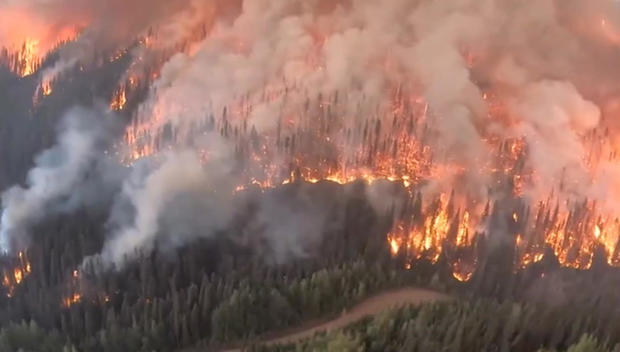Summer of Smoke: Inside Canada's hub of operations as nation battles 5,000 wildfires
WINNIPEG, Manitoba — The country known as "The Great White North" is also known for being green, as Canada is home to nearly 10% of the world's forests.
Those same forests, however, are now the fuel to what is perhaps the most intense wildfire season in the nation's history, if not the most significant wildfire crisis around the globe. More than 5,000 fires have raged since May across Canada, tearing through at least 29 million acres of land — and counting.
Tens of thousands of Canadians have been displaced from their homes because of the flames, while the mountainous plumes of smoke continue to pollute large swaths of North America, including Minnesota and Wisconsin as well as other parts of the Midwest and East Coast.
To help bring answers to what's happening — and why — CBS Minnesota station WCCO traveled to Canada to spend several days north of the border and was among the very first American news operations to get inside access to firefighting operations.
"Typically we deal with five to 10 to 25 to 50 new fires a day," Ontario wildfire officer Chris Marchand explained to WCCO News. "That's the grind of the summer fire season, to knock those fires off the list and to respond to the new ones that come up."
RELATED: What to do during an air quality alert: Expert advice on how to protect yourself from wildfire smoke
Indeed, every Canadian province and territory has been affected, from Newfoundland in the east to British Columbia in the west to the prairies in between.
"I was born and raised in Alberta, and I have been here for most of my life. I have to say we haven't seen a season like this," Alberta wildlife officer Christie Tucker lamented. "Our last record for area burned was set 40 years ago, and we've broken that already and it's not even the end of the season yet."
Mike Westwick, Northwest Territories wildfire officer, said the province has ordered more evacuations this year than it had for decades.
"This is a really severe fire season," Westwick said.
In Quebec, Deborah Beard is one of the more than 2,000 American firefighters who have crossed the border to join the lifesaving effort.
"We've been told that these are fires they have not had even recorded in anybody's lifetime. It's historically dry for them," Beard said. "It is nothing but a contiguous forest of fuel."
Inside CIFFC: "You work with where you can be successful"
WCCO News worked with multiple government ministries, in addition to the Canadian Embassy in Washington, D.C. According to officials, all firefighting operations are led by each province and territory, including strategizing how, where and when to direct resources to specific fires within their provincial lines.
One quasi-official organization, however, has emerged as the key hub of resource-sharing and multi-front operations: the Canadian Interagency Forest Fire Centre, CIFFC.
Established in 1982, CIFFC is a federally-supported not-for-profit organization whose specific mandate is to "improve Canadian wildland fire management," and it's a mission now that has perhaps as much urgency as any time in its history.
RELATED: How to protect your pets from wildfire smoke
"We're active everywhere, and all agencies are actively involved in suppressing fires in their own backyards," Dave Bokovay, CIFFC director of operations, told WCCO News. "We've reached out to right around the globe. We have firefighters and representatives on the ground from almost all continents except Antarctica. We've all got all continents providing resources to help support the situation."
The office itself is underwhelming, located in a Winnipeg strip mall only minutes from the city's airport.
"I hope this is not the new normal. I think we have to be prepared for these seasons in the future and that we may see more of this significant activity in the future," Bokovay said.
In addition to an operations room, there are several makeshift offices inside the complex, many of which are adorned with flags of the 12 nations that have provided both firefighters and firefighting apparatus to Canada.
"We did bring Chile in, we brought Portugal, Spain, Korea, Brazil. All brand-new countries that we have not had a pre-established relationship, and made interim plans to bring those folks in," Bokovay said. "Our longest relationship is with the United States. We've had an agreement with the U.S. since 1982 and we've exchanged resources either from the U.S. to Canada or from Canada to the U.S. or both every year except for three since 1982. Our biggest collaborator has been the United States."
As to how those resources are allocated, Bokovay said each province makes a request to CIFFC, which then coordinates that request with the corresponding country.
"We're planning for a marathon versus a sprint, and I think that's the way we've had to look at it the last couple of months," he said. "This is what we do. Our challenge is to support our fire management agencies and provide them with as many resources as we can possibly find. We find it a challenge, but we find it rewarding when we're able to do that."
And they'll have to do it without ever knowing when this will end.





